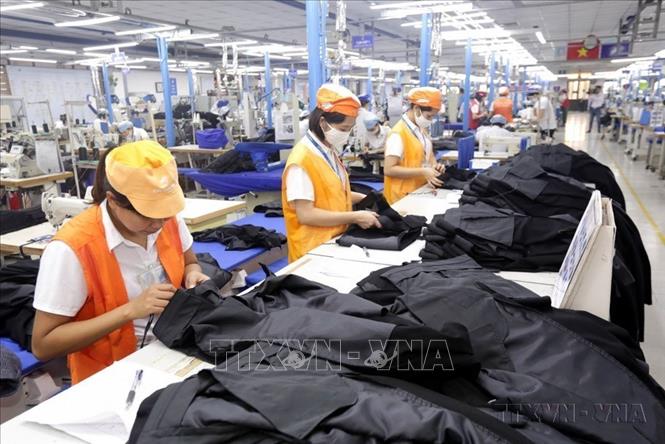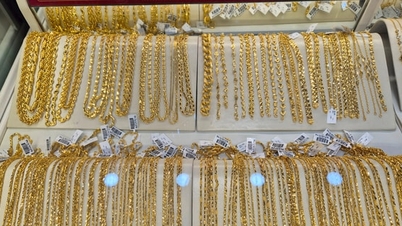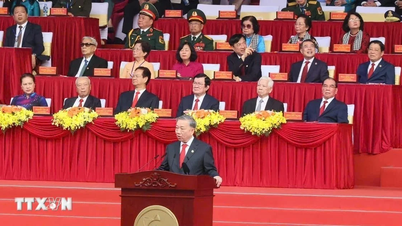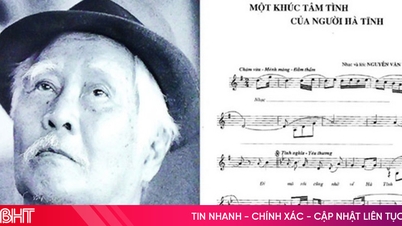
Garment production at the Shirt and Vest Factory of Garment Corporation 10 in Sai Dong, Long Bien District, Hanoi. Illustrative photo: Anh Tuan/VNA
On April 9, US President Donald Trump decided to suspend tariffs for 90 days and reduce reciprocal tariffs to 10% for more than 75 countries. On the afternoon of April 9, 2025 (local time), within the framework of his visit to the United States as Special Envoy of General Secretary To Lam to discuss bilateral economic and trade issues, Deputy Prime Minister Ho Duc Phoc met with US Trade Representative Jamieson Greer. At this meeting, the two sides agreed that Vietnam and the United States will negotiate a reciprocal trade agreement.
Currently, in parallel with the efforts of the Government and relevant agencies, Vietnamese enterprises in various economic sectors and fields, especially those in export product groups, are urgently establishing mechanisms to adapt to the new situation.
Mr. Ngo Sy Hoai, Vice President of the Vietnam Timber and Forest Products Association (Viforest), said that the US tax policy is quite complicated, and currently, member enterprises of the association have high expectations for timely support solutions from the Government and relevant agencies. Along with that, enterprises in the wood and wood products industry also need to carefully study the market strategy, take advantage of opportunities to promote export activities to this market so as not to be greatly affected, Mr. Ngo Sy Hoai said.
In the new context and to cope with the challenges of tariff policies, a representative of garment enterprises, Mr. Truong Van Cam, Vice President of the Vietnam Textile and Apparel Association (Vitas), said that Vietnamese enterprises must diversify markets and boost exports to other markets that have signed free trade agreements (FTAs).
To support textile and garment enterprises, in addition to negotiation efforts, it is necessary to simultaneously propose specific solutions to gradually reduce the trade deficit with the US; make efforts to accelerate the signing of new free trade agreements to exploit other potential markets such as Canada. In addition, it is necessary to maintain policies to support enterprises to reduce costs such as reducing value added tax, import tax, land tax, corporate income tax, etc.; or continue to reduce loan interest, defer debt, extend debt, and maintain the same debt group for enterprises, etc.
For businesses, Vitas also recommends that member businesses negotiate subsequent orders by sharing benefits and risks throughout the supply chain, from raw material suppliers to manufacturers, distributors to end consumers; at the same time, enhancing traceability and transparency of raw material supply information.
Ms. Phan Thi Thanh Xuan, Vice President and General Secretary of the Vietnam Leather, Footwear and Handbag Association, commented that in the near future, not only the US market, Vietnam has up to 16 free trade agreements with other countries; of which, two very large agreements are the Vietnam - EU Free Trade Agreement (EVFTA) and the Comprehensive and Progressive Agreement for Trans-Pacific Partnership (CPTPP), as well as the UK market. Therefore, continuing to diversify export markets as well as taking advantage of the advantages of markets with free trade agreements is still a priority for businesses. In addition, the above challenges are probably also an opportunity for businesses to restructure the production process, increase labor efficiency, and reduce input costs.
Ms. Thanh Xuan also recommended that ministries and branches need to have better policies, especially preferential policies, reform of administrative procedures, taxes, and customs, helping businesses to get tax refunds faster, customs procedures more open, creating favorable conditions for businesses to save costs in the production process.
In addition, businesses also need to prepare solutions such as importing raw materials available in the US market, leather products that are strong, or high technology from the US for the footwear industry... to help the footwear and handbag industry rebalance the trade balance, Ms. Phan Thi Thanh Xuan emphasized.
Mr. Ngo Sy Hoai also shared more about the adaptation and solutions that wood industry enterprises are implementing. Accordingly, wood exporting enterprises are focusing on finding competitive input materials to access more potential markets; focusing on effectively developing legal wood materials, with sustainable forest management certificates and high quality. In addition, enterprises have quickly considered increasing imported goods and products from the US, especially wood products such as sawn timber, round timber and veneer... to balance the trade balance; at the same time, designing other solutions so that the US side can see the benefits of cooperating with Vietnam...
Not only that, many wood industry enterprises are proactively approaching other potential markets such as Japan, Australia, Europe, China and new markets in the Middle East...
In the long term, Vietnamese wood enterprises need to change their business model from mainly processing according to importers' orders (OEM), to proactively designing (ODM) and building brands (OBM) to increase business efficiency, Mr. Ngo Sy Hoai noted.
Source: https://baobinhphuoc.com.vn/news/4/171510/doanh-nghiep-khan-truong-thiet-lap-co-che-thich-ung


![[Photo] Chinese, Lao, and Cambodian troops participate in the parade to celebrate the 50th anniversary of the Liberation of the South and National Reunification Day](https://vphoto.vietnam.vn/thumb/1200x675/vietnam/resource/IMAGE/2025/4/30/30d2204b414549cfb5dc784544a72dee)
![[Photo] The parade took to the streets, walking among the arms of tens of thousands of people.](https://vphoto.vietnam.vn/thumb/1200x675/vietnam/resource/IMAGE/2025/4/30/180ec64521094c87bdb5a983ff1a30a4)



![[Photo] Cultural, sports and media bloc at the 50th Anniversary of Southern Liberation and National Reunification Day](https://vphoto.vietnam.vn/thumb/1200x675/vietnam/resource/IMAGE/2025/4/30/8a22f876e8d24890be2ae3d88c9b201c)
















![[Photo] Performance of the Air Force Squadron at the 50th Anniversary of the Liberation of the South and National Reunification Day](https://vphoto.vietnam.vn/thumb/1200x675/vietnam/resource/IMAGE/2025/4/30/cb781ed625fc4774bb82982d31bead1e)






































































Comment (0)